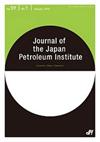基于化学环技术的CO2分离利用能量转换材料与系统设计
IF 0.6
4区 工程技术
Q4 ENERGY & FUELS
引用次数: 0
摘要
政府间气候变化专门委员会(IPCC)的最新报告提供了明确的证据,表明人类的影响已经使大气、海洋和陆地变暖,并要求进一步减少二氧化碳的排放。因此,创新的新技术,包括二氧化碳的分离、储存和利用,对于到2050年实现净零排放是必不可少的。化学环(CL)技术具有在全球范围内减少二氧化碳排放的潜力。化学环燃烧(CLC)过程的基本概念由Lewis和Gilliland于1953年在一项专利中提出。“化学循环燃烧(Chemical-Looping Combustion, CLC)”一词最早由Ishida等人在一项热力学研究中提出。CL系统的主要特点是使用循环金属氧化物颗粒作为氧载体(OCs)的多反应器系统进行顺序氧化还原反应和CO2分离。氧化还原循环在每个反应器中分别生成CO2、H2和N2,并产生高品位的热量。因此,CL系统可以分离二氧化碳并减少二氧化碳排放。因此,涉及金属氧化物的氧化还原反应对于CL系统在发电、制氢和储能中的应用是重要的(5)~7)。各种CL系统如图1所示。在典型的CL系统中,OCs在燃料反应器(FR)和空气反应器(AR)之间循环,即OCs被反复还原(式(1))和再氧化(式(2))。在这些反应中,碳质燃料(CmHn)在FR中转化为CO2,并在AR中产生高级热量,利用汽轮机发电,如图1(a)所示。提出了一种采用三个反应器的CO2分离CL制氢系统,将OCs与蒸汽部分氧化生成H2(式(3)),如图1(b)所示。此外,还提出了一种先进的CL系统,采用可逆固体氧化物燃料电池/固体氧化物电解电池(SOFC/SOEC)系统进行能量转换和存储,即CLtype空气电池,如图1(c)所示。H2H2O体系作为氧化还原介质(式(3))8、9)。(2n + m)MO + CnH2m→(2n + m) m + nCO2 + mH2O本文章由计算机程序翻译,如有差异,请以英文原文为准。
Materials and Systems Design for Energy Conversion with CO2 Separation and Utilization Using Chemical-looping Technology
The latest report of the Intergovernmental Panel on Climate Change (IPCC) has provided unequivocal evidence that human influence has warmed the atmosphere, ocean, and land, and demands further reduction of CO2 emissions1). Therefore, innovative new technologies, including separation, storage, and utilization of CO2, are indispensable for achieving net-zero emissions by 2050. Chemical looping (CL) technologies have the potential for reducing CO2 emissions worldwide. The basic concepts of chemical looping combustion (CLC) processes2) were presented in a patent by Lewis and Gilliland in 19543). The term “Chemical-Looping Combustion (CLC)” was first proposed by Ishida et al. in a thermodynamic study4). The main features of CL systems are sequential redox reactions and CO2 separation using multi-reactor systems with circulating metal oxide particles acting as oxygen carriers (OCs). The redox cycles form CO2, H2, and N2 separately in each reactor as well as generate high-grade heat. Consequently, CL systems can separate CO2 and reduce CO2 emissions. Therefore, redox reactions involving metal oxides are important for application to CL systems in power generation, hydrogen production, and energy storage5)~7). Various CL systems are shown in Fig. 1. In a typical CL system, the OCs circulate between the fuel reactor (FR) and the air reactor (AR), i.e., the OCs are reduced (Eq. (1)) and reoxidized (Eq. (2)) repeatedly. During these reactions, carbonaceous fuels (CmHn) are converted to CO2 in the FR and generate high-grade heat in the AR to produce electricity using a steam turbine, as shown in Fig. 1(a). A CL hydrogen production system with CO2 separation using three reactors was proposed for partially oxidizing OCs with steam to form H2 (Eq. (3)), as shown in Fig. 1(b). In addition, an advanced CL system involving energy conversion and storage with a reversible solid oxide fuel cell/solid oxide electrolytic cell (SOFC/SOEC) system, the CLtype air battery, has been proposed, as shown in Fig. 1(c). The H2H2O system acts as a redox mediator (Eq. (3))8),9). (2n + m)MO + CnH2m → (2n + m)M + nCO2 + mH2O (1)
求助全文
通过发布文献求助,成功后即可免费获取论文全文。
去求助
来源期刊

Journal of The Japan Petroleum Institute
工程技术-工程:石油
CiteScore
1.70
自引率
10.00%
发文量
29
审稿时长
>12 weeks
期刊介绍:
“Journal of the Japan Petroleum Institute”publishes articles on petroleum exploration, petroleum
refining, petrochemicals and relevant subjects (such as natural gas, coal and so on). Papers published in this journal are
also put out as the electronic journal editions on the web.
Topics may range from fundamentals to applications. The latter may deal with a variety of subjects, such as: case studies in the development of oil fields, design and operational data of industrial processes, performances of commercial products and others
 求助内容:
求助内容: 应助结果提醒方式:
应助结果提醒方式:


